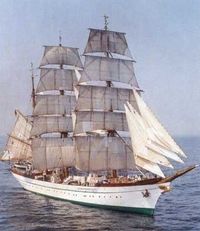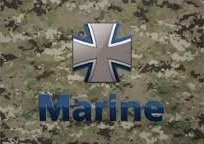------------------------------------------------------------------
Back on the East Arm of the Great Slave Lake
The scenary is unreal there..
Back in "Vortex" cove, too bad the guys left...
We catch a nice Lake Trout
Man the Great Slave Lake trout could be in any gourmet restaurant !
One of the many double rainbows we have seen on this trip...
The colors where so bright...
ORCA at the Yellowknife Great Slave Yacht Club
Downtown Yellowknife
Capital of the Northwest Territories since 1967, Yellowknife is named after the Yellowknife Dene who moved into the area in the early 1800's. It lies within the traditional hunting area of the Dogrib Tribe who re-occupied the land following the decline of the Yellowknife Chipewyans in the 1820's.
As a result of Alexander Mackenzie's visit in 1789, a trading post, known as Fort Providence, was established near the mouth of Yellowknife Bay. This post was still in existence 31 years later when Franklin made his journey to the Coppermine River in 1820, but was abandoned shortly afterwards.
In 1896 gold was discovered at Yellowknife Bay by miners on their way to the Klondike. There was no great staking rush at this time, however, because of the inaccessibility of the country. It was not until about 1930, with the discovery of pitchblende on Great Bear Lake, and the advent of aircraft travel in the north, that further development took place.In 1934 visible gold was found on the shores of Yellowknife Bay, and by 1936, Yellowknife was a boom town. A number of companies, including Consolidated Mining and Smelting Company of Canada, began to sink shafts on the "Con", "Negus", and "Giant" claims during 1936 and 1937.
Commercial gold production began in the Yellowknife district in December 1938. In 1939 the Yellowknife Administration District was created and the first municipal government of the MacKenzie district was established the following year. By 1940, Yellowknife had a population of 1,000.Development was halted soon after, however, when in 1942 two of the six mines were closed. The primary reason for the drop in production was two-fold: one, gold was not a strategic resource during the war effort, and concurrently, there were fewer men to work the mines as they were needed for military service during World War II. By the fall of 1944, gold production in the area had ceased entirely.
A new rush began again at the end of the war when Giant Yellowknife Mine opened. By this time, the town was very overcrowded as it grew out around the Bay in Old Town. A new town site was surveyed and construction of New Town began in 1947. By the end of that year, gold mines were once again in full-scale production. A significant factor which aided in the expansion of Yellowknife was the completion of a hydro-electric power station on Snare Lake in 1948. This facility did much to alleviate power shortages which had previously hindered operations in the area.
Yellowknife became a Municipal District in the summer of 1953 at which time its first mayor was elected. In 1967, it was named as capital of the Northwest Territories, and on January 1, 1970, Yellowknife became the first city in the Northwest Territories.
The City has continued to grow as a mining, transportation, communications and administrative centre, while retaining the character and spirit of a small northern town. In 1996, with a population of over 18,000, the City sparkles with the anticipation of diamond mine development north of the city.
The famous Wildcat Cafe
In the harsh conditions of Canada's northern frontier, prospectors, bush pilots, miners, and trappers established places where they could meet to exchange information and stories.
Built in 1937, the Wildcat Cafe in Yellowknife, Northwest Territories, was a popular gathering spot which served at various times as an eatery, Chinese restaurant and ice cream and soda stand. At one time it even featured steam baths in an adjacent building – a useful service in a frontier town with limited water services. It also became a symbol of community and identity in a region where distance, a scattered population, and climatic extremes posed tremendous challenges.
In the 1970s a volunteer group, the Old Stope Association, undertook to save the Wildcat Cafe from demolition after many years of disuse. It was one of the last remaining buildings in what had been the thriving commercial centre of Yellowknife in the 1940s. The Association would eventually renovate and reopen the building in 1979 as a restaurant featuring Northern fare such as caribou and fish.
First Nation Art in Old Town Yellowknife
Nice view at Old Yellowknife
Old Town is so called for a pretty basic reason. It is the original settlement of Yellowknife. Nestled on the North Arm of Great Slave Lake (the ninth largest lake in the world) Old Town grew up alongside the small Dene community of N’dilo.
Back to Hay River
We where again very lucky, the Lake was calm...
Ready to dive in the Caribou Bay at the Great Lake North Shore.The diving in the Lake up here was a bit dissapointing. Not muchto see beside stones and the visibility was not very good in thegreenish water...
ORCA back in Hay River, ready for an oil change and some repacking and cleaning
The Honda Engine is getting some fresh Oil...
The food for the rest of the Expedition has to be packed
Orca is getting back in the Water...
Next: Mackenzie River 1
Only those who risk going too far, will discover how far they can go!
Expedition in USA, Alaska & Canada, Scandinavia with folding boat, motorboat, catamaran, motorcycle, off-road vehicle, bicycle ...

























